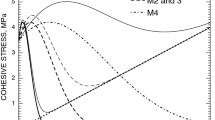Abstract
Recent observations made by Kanamori and Allen about earthquake recurrence time and average stress drop revealed a very interesting relation: earthquakes with longer recurrence times have higher average stress drops. They attributed the difference in stress drop to the difference in long-term average slip rate. To interpret their result in terms of the healing effect, we simulated earthquake recurrence with a one-dimensional mass-spring model, incorporating a recently developed rate-and-state dependent friction law for different loading rates and heterogeneous strength distributions. We first calculated the stress drop and recurrence time as functions of loading rate for a homogenous fault model. We found that the stress drop increases up to 30% when the loading rate decreases from 10 cm/yr to 0.01 mm/yr. Thus, the observed great variability of stress drop, from a few bars to a few hundred bars, which is obtained by replotting the data of Kanamori and Allen in the form of stress drop versus long-term slip rate, may not be attributable to the healing effect alone. Our numerical simulation shows that the variability may be due primarily to the spatial heterogeneity of strength on the fault. Our simulation also suggests that of the two empirical laws that were inferred from the same laboratory friction data, called the power law and the logarithmic law by Shimamoto and Logan, the former can explain the observed relation between stress drop and slip rate better than can the latter, at least for strike-slip fault. The logarithmic law is an earlier and simpler version of the rate-state-dependent friction law.
Similar content being viewed by others
References
Brune, J. E. (1970),Tectonic stress and the spectra of seismic shear waves from earthquakes. J. Geophys. Res.75, 4997–5009.
Burridge, R. andKnopoff, L. (1967),Model and theoretical seismicity. Bull. Seismol. Soc. Am.57, 341–371.
Cao, T. andAki, K. (1984),Seismicity simulation with a mass-spring model and a displacement hardeningsoftening friction law. Pure Appl. Geophys.112, 10–24.
Cao, T. andAki, K. (1986),Seismicity simulation with a rate-and-state-dependent friction law. Pure Appl. Geophys.124 No. 3, 487.
Cohen, S. C. (1977),Computer simulation of earthquakes. J. Geophys. Res.82, 3781–3796.
Cohen, S. C. (1979),Numerical and laboratory simulation of fault motion and earthquake occurrence. J. Geophys. Res.17, 61–72.
Dieterich, J. H. (1972),Time-dependent friction as possible mechanism for aftershocks. J. Geophys. Res.77, 3771–3781.
Dieterich, J. H. (1979),Modeling of rock friction: I. Experimental results and constitutive equations. J. Geophys. Res.84, 2161–2168.
Dieterich, J. H. (1980),Experimental and model study of fault constitutive properties. ASME Appl. Mech. Div., Solid Earth Geophys. Geotech., ed. S. Nemat-Nasser, ASME, New York, pp. 21–29.
Dieterich, J. H. (1981), ‘Constitutive properties of faults with simulated gouge, inMechanical Behavior of Crustal Rocks. Monograph 24 (N. L. Carter, M. Friedman, J. M. Logan and D. W. Stearns, eds.), Am. Geophys. Union, pp. 103–120.
Kanamori, H. (1972),Determination of effective tectonic stress associated with earthquakes faulting: The Tottori earthquake of 1943. Phys. Earth Planet. Inter.5, 426–434.
Kanamori, H. andAllen, C. R. (1985),Earthquake repeat time and average stress drop, submitted to 5th Ewing Symp. Earthquake Source Mechanics.
Papageorgiou, A. andAki, K. (1983),A specific barrier model for the quantitative description of inhomogeneous faulting and the prediction of strong ground motion: II. Applications of the model. Bull. Seismol. Soc. Am.73, 953–978.
Rice, J. R. andTse, T. (1986),Dynamic motion of a single degree of freedom system following a rate and state dependent friction law. J. Geophys. Res.91, 521–530.
Richardson, R. S. H. andNolle, H. (1976),Surface friction under time-dependent loads. Wear37, 87–101.
Rudnicki, J. W. andKanamori, H. (1981),Effects of fault interaction on moment, stress drop and strain energy release. J. Geophys. Res.86, 1785–1793.
Ruina, A. (1980),Friction laws and instabilities: A quasi-static analysis of some dry friction behavior. Ph.D. Thesis, Brown University.
Ruina, A. (1983),Slip instability and state variable friction laws. J. Geophys. Res.88, 10359–10370.
Rundle, J. B., Kanamori, H. andMcNally, K. C. (1984),An inhomogeneous fault model for gaps, asperities, barriers, and seismicity migration. J. Geophys. Res.89, 10219–10231.
Schwartz, D. P. andCoppersmith, K. J. (1984),Fault behavior and characteristic earthquakes: Examples from the Wasatch and San Andreas fault zones. J. Geophys. Res.89, 5681–5698.
Shimamoto, T. andLogan, J. M. (1984),Laboratory friction experiments and natural earthquakes: An argument for long-term tests. Tectonophysics109, 165–175.
Sykes, L. R. andQuittmeyer, R. C. (1981), ‘Repeat times of great earthquakes along simple plate boundaries’, inEarthquake Prediction, An international Review, (D. W. Simpson and P. G. Richards, eds.), Am. Geophys. Union, Washington, D.C., 680 pp.
Tse, S. T. andRice, J. R. (1986),Crustal earthquake instability in relation to the depth variation of frictional slip properties. J. Geophys. Res.91, 9452–9472.
Tullis, T. E. andWeeks, J. D. (1986),Constitutive behavior and stability of frictional sliding of granite. Pure Appl. Geophys.124, No. 3, 383.
Weeks, J. D. andTullis, T. E. (1985),Frictional sliding of dolomite: A variation in constitutive behavior. J. Geophys. Res.90, 7821–7826.
Yamashita, T. (1976),On the dynamical process of fault motion in the presence of friction and inhomogeneous initial stress: Part I. Rupture propagation. J. Phys. Earth24, 417–444.
Author information
Authors and Affiliations
Rights and permissions
About this article
Cite this article
Cao, T., Aki, K. Effect of slip rate on stress drop. PAGEOPH 124, 515–529 (1986). https://doi.org/10.1007/BF00877214
Received:
Revised:
Accepted:
Issue Date:
DOI: https://doi.org/10.1007/BF00877214




